Template for writing a letter of recommendation
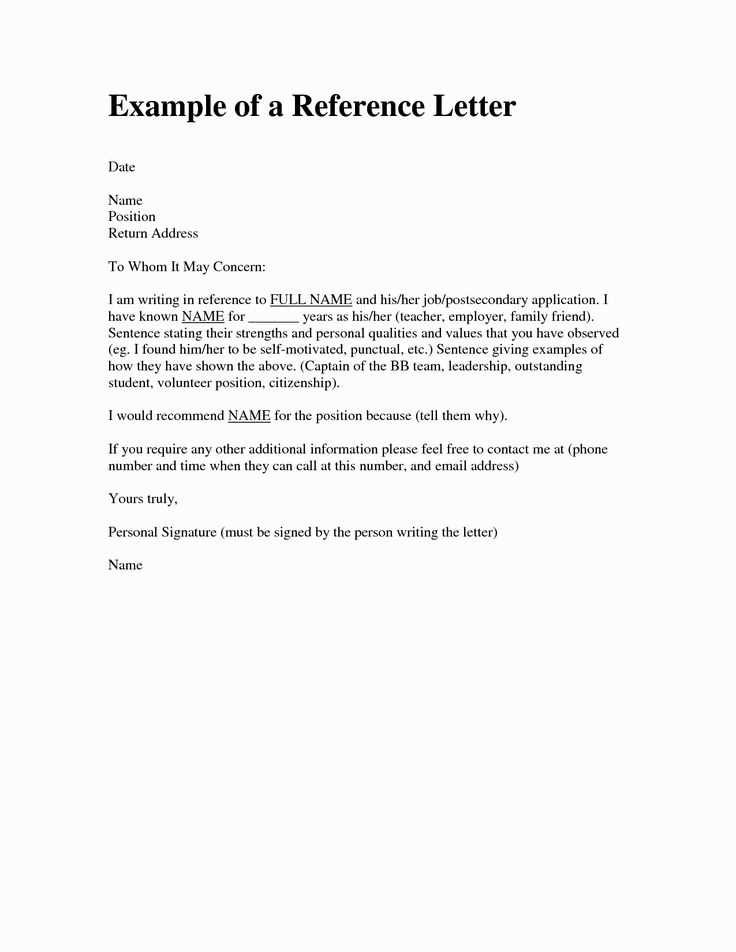
A strong letter of recommendation highlights specific achievements, skills, and qualities that set an individual apart from others. Start by clearly identifying the relationship between you and the person you’re recommending. This establishes credibility and context for the reader.
Begin with a concise introduction that explains who you are, how you know the applicant, and the duration of your relationship. For example, if you’re recommending a colleague, mention the projects you’ve worked on together or the team you’ve both been part of. This helps the reader understand your firsthand knowledge of the applicant’s abilities.
Next, focus on specific qualities that make the individual stand out. Highlight their work ethic, problem-solving skills, leadership qualities, or any relevant expertise. Use concrete examples to show how these traits manifested in their actions, rather than general statements.
Conclude by strongly reaffirming your support for the applicant. Offer a clear statement that you believe they will excel in the role or opportunity they are seeking. If applicable, include your contact information for follow-up questions, demonstrating that you are available to discuss further details.
This structure ensures that your recommendation is clear, focused, and impactful, providing the recipient with valuable insights into the applicant’s qualifications and character.
Template for Writing a Letter of Recommendation
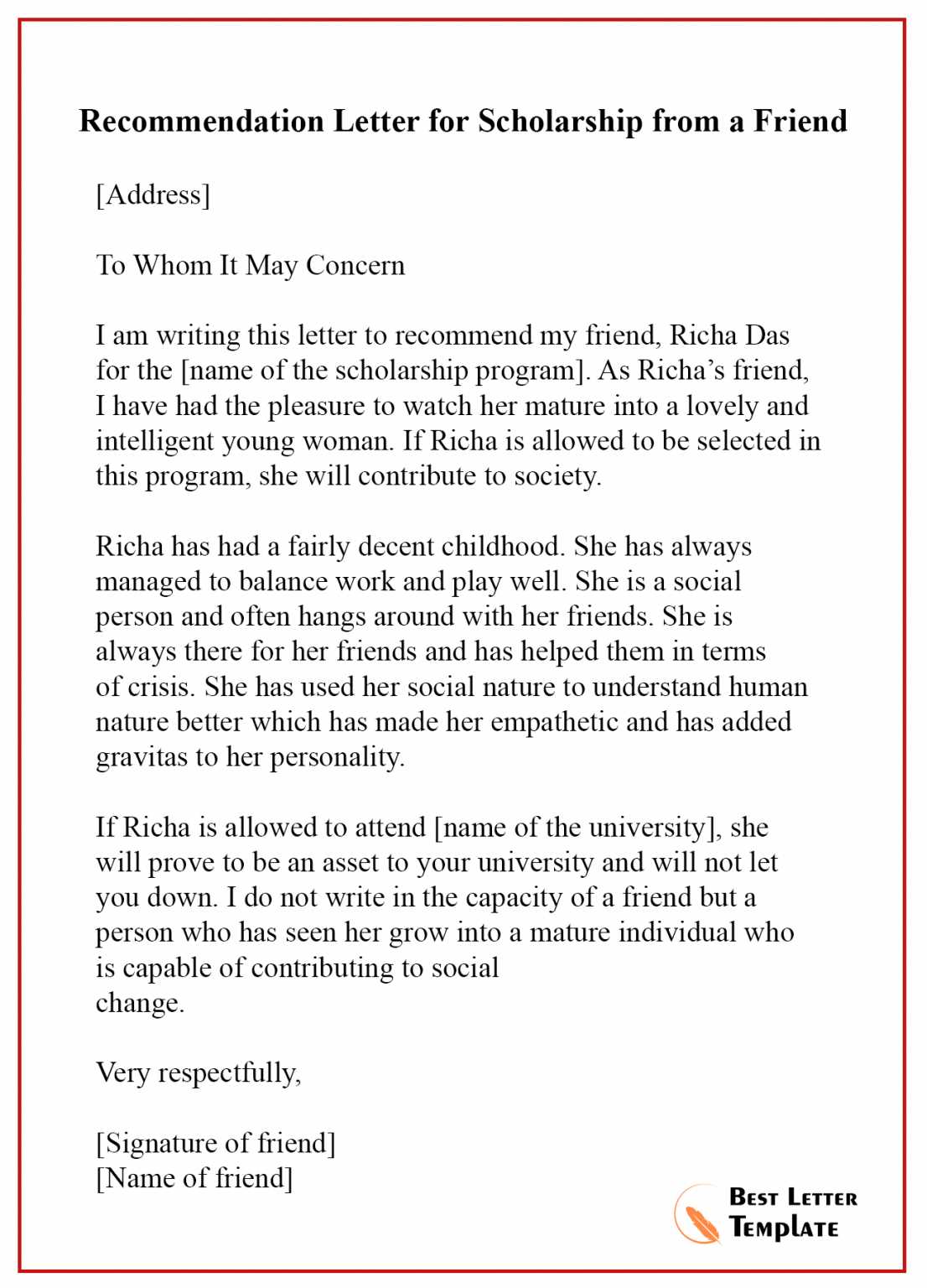
A well-crafted letter of recommendation should highlight the strengths and specific achievements of the person being recommended. Here’s a template you can follow to write a clear and impactful letter.
Opening Paragraph
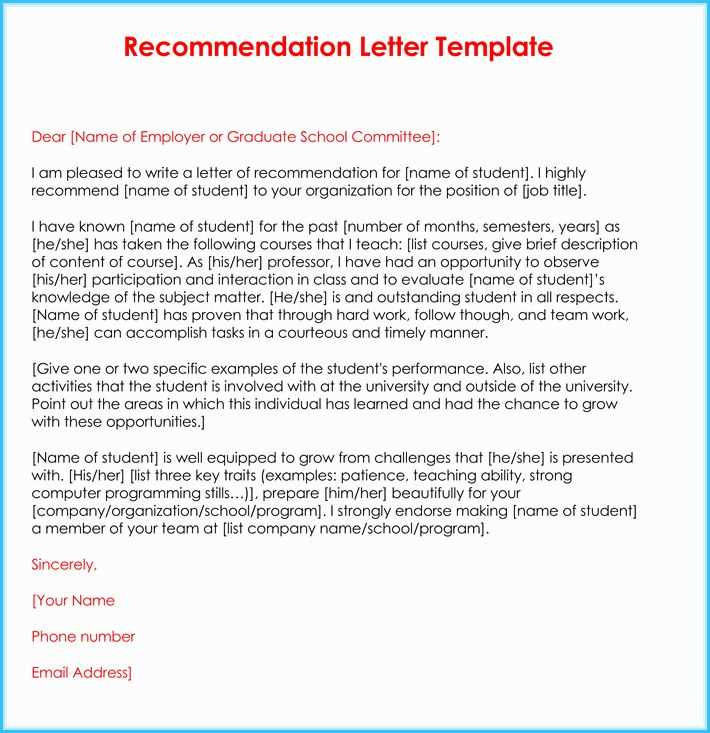
Begin by introducing yourself and your relationship with the candidate. Be specific about how you know them and the duration of your connection. Mention their role and why you are qualified to provide a recommendation. Example:
“I have had the pleasure of working with [Candidate’s Name] for [number] years at [Company/Organization]. As their [Your Position], I had the opportunity to observe their work closely and assess their performance in various challenging projects.”
Middle Paragraph(s)
In these paragraphs, focus on the key qualities that make the candidate stand out. Mention specific skills, experiences, or projects that demonstrate their abilities. Use concrete examples to provide evidence of their achievements. Avoid general statements and be clear about the impact they had. Example:
“[Candidate’s Name] consistently demonstrated exceptional skills in [area of expertise], especially during [specific project or task]. They handled [describe situation] with outstanding attention to detail, innovative solutions, and a positive attitude that motivated the team.”
Include any notable accomplishments that are directly relevant to the position or opportunity the candidate is applying for. Example:
“Their contribution to [specific achievement] resulted in [specific outcome], which had a measurable impact on the team’s success. I was particularly impressed by their ability to [describe another key skill or trait].”
Closing Paragraph
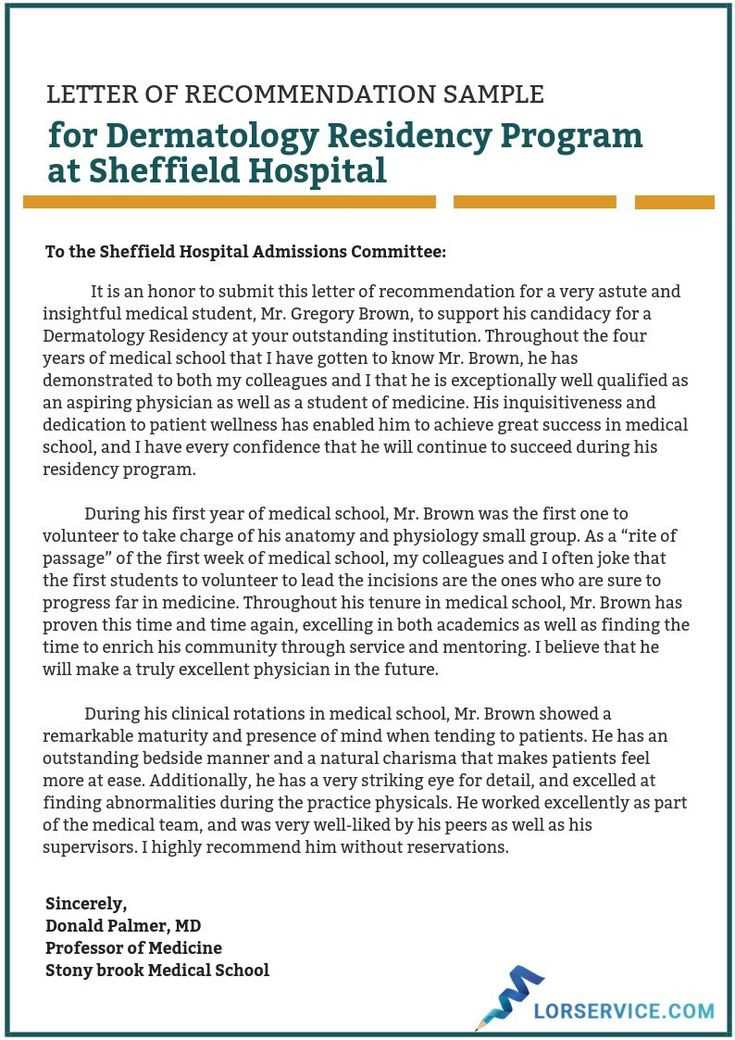
Wrap up your letter by summarizing the candidate’s strengths and expressing your full support for their application. End with a clear statement that you are confident in their abilities. Example:
“I wholeheartedly recommend [Candidate’s Name] for [position, program, or opportunity]. Their skills, work ethic, and dedication make them an excellent fit for this role, and I am confident they will continue to excel in all their future endeavors.”
Provide your contact information for further inquiries. Example:
“Please feel free to contact me at [Your Email] or [Your Phone Number] if you need additional information.”
How to Start the Letter: Crafting a Strong Opening
Begin the letter by clearly stating your relationship with the candidate. Specify how long you’ve known them and in what capacity. This immediately establishes your credibility and provides context for the recommendation. Make sure to include details that highlight your unique perspective on the candidate’s qualifications.
For example, avoid vague phrases like “I’ve worked with Jane for many years.” Instead, be specific: “I have worked closely with Jane for three years as her direct supervisor at XYZ Company.” This helps set the stage for the rest of your letter.
Next, mention the role or opportunity the candidate is applying for. This gives the reader immediate insight into the context of your recommendation. This will also allow you to tailor the letter to the specific strengths that are most relevant to the role.
Try to open with an impactful sentence that conveys your enthusiasm or confidence in the candidate’s abilities. A strong opening makes a positive first impression and sets the tone for the rest of the letter.
| Weak Opening | Strong Opening |
|---|---|
| “I am writing to recommend Jane Doe.” | “I have had the privilege of supervising Jane Doe for the past three years at XYZ Company, where she consistently impressed me with her dedication and leadership.” |
| “This letter is to recommend John Smith for your consideration.” | “As John’s manager for the last two years, I’ve witnessed firsthand his exceptional problem-solving skills and ability to handle high-pressure situations.” |
Choosing the Right Tone: Professional vs. Personal Voice
When writing a letter of recommendation, balance is key. Tailor your tone based on the recipient and purpose. A professional tone ensures respect and seriousness, which is important for formal contexts like academic or job applications. A personal tone builds warmth, highlighting your genuine connection with the person being recommended. Both can be used effectively, but choosing the right one impacts how your message is received.
Professional Tone
A professional tone emphasizes clarity, objectivity, and respect. Use formal language and avoid overly personal anecdotes. Stick to facts that showcase the individual’s qualifications and skills. It’s important to maintain a neutral, unbiased tone, focusing on the strengths that are directly relevant to the role or opportunity the person is pursuing. Phrases like “demonstrated excellence in” or “highly capable in” help convey professionalism without sounding distant.
Personal Tone
A personal tone allows you to speak more emotionally about the candidate. Share specific examples that illustrate their character, work ethic, or unique qualities. This approach is appropriate when you have a close relationship with the individual, such as a mentor or colleague. Avoid being too informal, but don’t hesitate to use language that reflects your personal connection, like “I’ve seen them grow into” or “I’ve witnessed firsthand how they excel in.” This tone should still maintain respect but feel more engaging and personable.
Highlighting Key Skills and Accomplishments: What to Include
Focus on specific skills and accomplishments that directly align with the position or program the candidate is applying for. Provide concrete examples that demonstrate their abilities in action.
- Key skills: Identify the candidate’s core competencies, such as technical skills, leadership, communication, problem-solving, and time management. Link these skills to actual situations where they were applied successfully.
- Impactful achievements: Highlight measurable outcomes. For example, mention how the candidate improved team performance by a certain percentage, led a project that resulted in a successful product launch, or streamlined a process that saved time or resources.
- Growth and development: Show how the candidate has advanced in their role, whether through increased responsibilities, overcoming challenges, or continuous learning. This reflects their adaptability and commitment to self-improvement.
- Problem-solving abilities: Share instances where the candidate tackled complex challenges. Describe the issue, the candidate’s approach to resolving it, and the outcome. This illustrates their critical thinking and decision-making skills.
- Leadership or teamwork: Mention leadership roles, mentoring, or collaboration on cross-functional teams. Provide examples of how they motivated others, fostered a positive working environment, or contributed to team success.
When describing accomplishments, use specific numbers or percentages to quantify success. This adds weight to the recommendation and gives the reader a clear sense of the candidate’s contributions.
Addressing Specific Qualities: How to Demonstrate Value
When writing a letter of recommendation, focusing on specific qualities allows you to provide concrete evidence of the individual’s strengths. Start by offering real-life examples that show the person’s reliability, problem-solving ability, or leadership skills. For example, instead of just stating that someone is a strong leader, describe how they managed a team during a high-pressure project, highlighting their decision-making process and the positive outcome of their efforts.
Instead of general praise, focus on measurable impacts. For instance, you could explain how the individual improved workflow by implementing a new system, increasing efficiency by 30%. This not only shows their capability but also demonstrates how their actions added tangible value to the organization or team.
Use numbers and specific results to make your point clearer. If the person contributed to a project that increased revenue or saved costs, mention the figures to show their direct impact. A statement like, “Their strategy increased sales by 15% over six months” gives a solid foundation for the reader to understand the candidate’s value.
Avoid vague claims or abstract qualities that are hard to verify. Instead of describing someone as “hardworking,” provide examples that show their dedication, such as working extended hours to meet a tight deadline without compromising the quality of their work. Showing actions over adjectives strengthens your recommendation.
Highlight qualities that align with the position or program the individual is applying for. Tailor your examples to match what the reader values most. If you’re recommending someone for a research role, mention their analytical skills and ability to synthesize complex data, offering specific examples of their success in this area.
Be concise but detailed. Make sure the reader walks away with a clear understanding of how this person contributed and why they stand out among peers. Offering evidence of their value makes your recommendation more convincing and impactful.
Making a Clear Recommendation: What Should You State?
State your recommendation directly and with confidence. Avoid vague statements and focus on the specific qualities or accomplishments that make the individual a strong candidate for the position or opportunity. Clearly explain why you believe they will succeed based on their skills, experience, and character. Mention specific achievements or actions that demonstrate their qualifications.
Provide Specific Examples
Supporting your recommendation with concrete examples can make it more persuasive. Highlight instances where the person excelled, whether through leadership, problem-solving, or a particular skill set. For example:
- How they led a project to completion on time and within budget.
- Instances where they demonstrated creativity in overcoming challenges.
- Key contributions they made that positively impacted a team or organization.
Be Clear About Their Potential
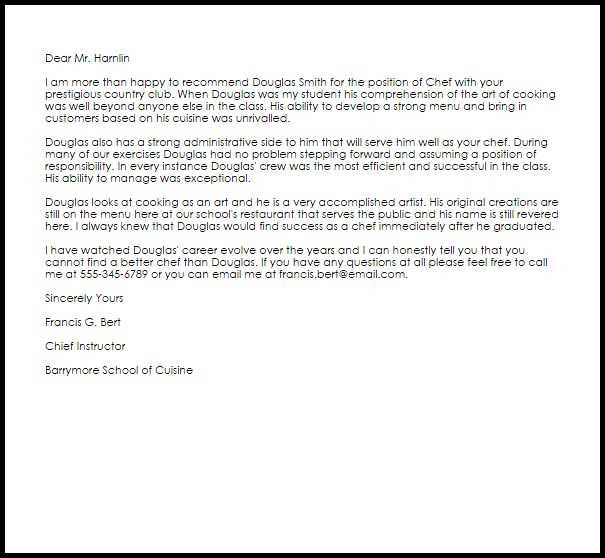
Express your confidence in their ability to succeed in the future. Focus on how their past performance predicts their success in new challenges. Mention how they are likely to handle future responsibilities and the impact they could make in the role they’re applying for.
End your recommendation by restating your endorsement. Be clear that you support their application and that you believe they will excel. Keep the tone positive, professional, and direct.
Closing the Letter: Offering Final Support and Contact Information
Conclude the letter by reaffirming your full support for the candidate’s potential. Clearly state your confidence in their abilities and readiness to assist in any further questions. Be specific about your willingness to provide additional insight, highlighting how you can be reached for follow-up queries.
Provide your contact details in a professional manner, ensuring the recipient can easily reach out. Include both email and phone number for flexibility. Mention your openness to discuss the candidate’s qualifications in more detail if needed.
Finish with a statement of gratitude, thanking the reader for their time and consideration of the recommendation. Keep the tone warm and approachable, encouraging them to get in touch if necessary.